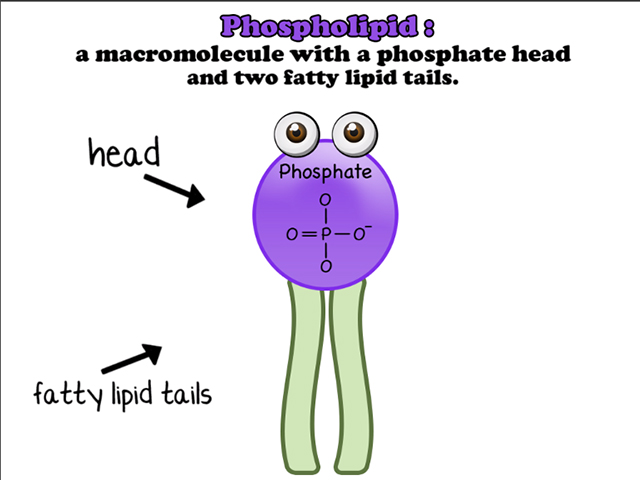The Plasma Membrane
Cell Membrane Structure and Function
All biological membranes are made of two main components:- Phosphorus, or phosphate groups (–H2PO4R, where R is a functional group)
- Lipids
Well-named, don’t you agree?


You may have read about lipids in relation to fats in an earlier unit. Lipids are constituents of fats. So yes, these lipids fall under the same category as the lipids we discussed in the other unit. Their aversion to water even makes them greasy or oily in consistency.
Phospholipids line up next to each other because part of the molecule is attracted to water (the "phospho" part), and the other part is repelled by water (the "lipid" part). Because the lipid part is repelled by water, it cannot be left out in the open, so another layer of phosopholipids will line up next to the first layer, with the "lipid" parts facing each other at the line where the two layers meet. At the same time, the "phospho" parts face outward toward the water on both sides of the line. As more and more "lines" of phospholipids are added adjacently to the first line, but in the same plane, a phospholipid bilayer is born!
Did we just confuse you? A picture is worth a thousand words:

Transmission electron micrograph image (Source)
Because phospholipid bilayers, also called "membranes," are so important to cells—meaning, every cell on Earth has at least one—we'll need to look at this cellular structure in a little more detail.
All prokaryotic cells have a phospholipid bilayer, or sometimes multiple bilayers, called the plasma membrane. This structure marks the boundary between the inside and outside of the cell, even though it is found on the inside of the prokaryotic cell wall. The cytoplasm and other prokaryotic cellular contents are found inside the plasma membrane.
All eukaryotic cells have a plasma membrane, too. They also sport additional phospholipid membranes surrounding internal structures like the nucleus, the mitochondria, and the chloroplasts. Each of these internal membranes plays a vital and unique role in the growth, survival, and development of the cell.
The Plasma Membrane
The plasma membrane marks the boundary between life and nonlife.It's a well-oiled machine, if you ask us:

This structure keeps the contents of a cell separate from the environment surrounding it. In addition to phospholipids, the plasma membrane has cholesterol molecules and proteins that allow the membrane to function properly.
Cholesterol molecules are primarily affect the rigidity of the plasma membrane. At lower temperatures, when the membrane would like nothing more than to freeze in place, cholesterol helps the membrane loosen up. At higher temperatures, though, cholesterol raises the melting point of the membrane, preventing it from smooshing into a mushy paste.
Proteins embedded in the membrane play important roles in helping the cell transport materials in and out and communicate with its environment, including with other cells.
There are two main types of membrane proteins:
- Those that transverse the membrane, called integral proteins
- Those that are stuck on the inside or outside of the membrane, called peripheral proteins
All of these membrane components—lipids, cholesterol molecules, and proteins—can move laterally, or side-to-side, through the membrane, causing biologists to consider it as a kind of fluid. However, since the membrane is made up of a number of different components, it can also be considered a kind of mosaic. Yes, like a piece of art. These two ideas come together in what is known as the "Fluid-Mosaic Model" of the plasma membrane7.
Biologists have also recently learned that the plasma membrane and the cytoskeleton interact very closely with one another8. Because the phospholipid bilayer is somewhat fluid, proteins embedded in the membrane could easily move around willy-nilly. To prevent this from happening, the cytoskeleton attaches to the membrane proteins and anchors them in place. Those guys aren't going anywhere.
The interior of the phospholipid bilayer is hydrophobic, so only very small, neutrally charged molecules—such as oxygen (O2), carbon dioxide (CO2), and water (H2O)—can pass freely through the membrane. Everything else must pass through a transmembrane protein, meaning the cell has general control over what gets in and what gets out.
The transmembrane protein can be thought of as the security guard at the door of the Sublime with Rome concert. He steals your plastic bottles and confiscates your food in the event that you get a little frisky and start chucking items at other concertgoers or, heaven forbid, at Rome because you still have pent-up aggression over Bradley's death, despite the fact that it was 15+ years ago. Poor Rome. Sorry, where were we again?
In short, the plasma membrane plays the very same roles for a cell as your skin, eyes, ears, mouth, and nose play for your body. The phospholipids provide protection to the cell, while membrane proteins allow it to "eat," "drink," and "breathe," as well as "feel," "see," and "hear," the outside environment.
Without the membrane proteins, a cell would lose all of its senses at once and would be as defenseless as a tree house in a tornado. We wouldn't want that, now would we? The plasma membrane is a very important part of the cell indeed.
Brain Snack
Your plasma membrane is the place where your cells meet all foreign material, including pathogens. Because of this fact, it's also the place where the cells of your immune system communicate with other cells.
